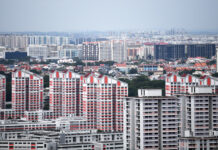SINGAPORE: For some years, Singaporean Leng Ng Tai had this as his home address – A, 4A, Pulau Bukom.
Located 5.5km southwest of mainland Singapore, Pulau Bukom which spans 243ha is more well-known as the location of Singapore’s first oil refinery, not the homes of people.
But Mr Leng, who was this year recognised for his 50 years of service with Dutch oil and gas firm Shell which owns the refinery, painted an almost idyllic picture of the island, instead of belching smoke and the whirring of machinery.
He described the location as one which provided him and his family unobstructed sea front views of the sunrise and sunset, a huge home, and a community where everyone knew and helped one another.
Accompanied by his son Benny, also a Shell employee, Mr Leng recounted to CNA how he was asked to move to the island with his family – his wife, 13-year-old son and 17-year-old daughter – so he could ensure that the site operates efficiently and optimally, as a part of his job as a Production Supervisor. They lived on the island from 1989 to 1997.
There were practical discussions to be had, Mr Leng, now a senior production advisor said. At the time, there were only a handful of shops on the island, which was then a 30-minute ferry ride away from the Pasir Panjang Terminal. And Mr Leng counted them off on his fingers – a beauty parlour, an electrical goods shop, barber shop, and a tailor.
GETTING FOOD ON THE ISLAND
“Food was the number one priority. How do we get food? Our vegetables, our meat, and other provisions? Besides that, any cooked food available? We did have a hawker centre here,” he said.
He was quick to declare that an Indian stall at the hawker centre on the island sold “the best prata in Singapore”.
As it turned out, Mr Leng had little need to eat at the hawker centre, as word of his wife Doris’ famed cooking spread on the island. People were turning up at his home to eat and gather instead.
The Lengs made sure their kitchen was well-stocked with fresh food in two large refrigerators and a commercial-sized freezer. Every Saturday was marketing day, and they would head for the wet market in Clementi or West Coast. Fish however was not on their “to buy” list.
They would buy fresh fish from the provision shop on the island. The fish was supplied by Indonesian fishermen who went around the Southern islands, Mr Leng said.
“They did barter trade with the provision shop. So in exchange for the fresh fish, they got rice, sugar and all those stuff. The fish was really fresh. The provision shop owner would call us to tell us that there is fresh fish,” Mr Leng said.
Mr Leng’s living room in his 3,000 sq ft home on Pulau Bukom: (Photo: Leng Ng Tai)
Mr Leng’s wife, Doris, would whip up large portions of food, so there was always enough for visitors. There was also no lack of space if they wanted to stay the night.
LIVING IN A 3,000SQ FT HOUSE
Mr Leng’s home is huge. It measured about 3,000sq ft (279 sq m), the size of three four-room HDB flats. His dining room alone could accommodate about 30 seated guests. There were two four-seater sofas and eight single seaters in the living room. The balcony provided standing space for more people.
The home had four bedrooms with en suite toilets.
“Our unit was also like a boarding house. Young technologists or chemical engineers, when they work late, they will call and say Aunty Doris, can I come and stay for the night and have dinner?” he said.
Mr Leng’s favourite part of staying with the Bukomites as they are called is the camaraderie, the “kampung spirit” as he described it. Including Mr Leng’s family, 28 families lived in two blocks on one part of the island, while on another part of the island, about 30 families made up of firemen and policemen lived.
Benny and his sister ended up babysitting the younger children from the two blocks. Their neighbours would ask if they could leave their children at their home, and they would agree, Benny said. His sister would teach the children art as she’s good at it.
Their doors were never locked, a la kampung life. Sometimes, Benny said he would suddenly find one of the neighbours’ children beside him.
NO LACK OF ACTIVITIES
The residents kept themselves busy.
“Every alternate Friday, we had potluck, we got together. Almost all the families got together. Each one brought a dish, and we enjoyed our Friday evening on the island. So it’s very sociable environment, where everybody knows one another, from the adults, right down to the children going to school,” Mr Leng said.
A children’s party on Pulau Bukom when Mr Leng Ng Tai used to live there with his family. (Photo: Leng Ng Tai)
Every Wednesday for six years, a dancing instructor would be ferried in from mainland Singapore and give lessons. They learned different dance styles like the cha cha.
“Mind you, it is not that (at) the end we graduated to be good dancers,” Mr Leng said, laughing.
Thursdays, Saturdays and Sundays were free movie nights at the theatre which could hold 200 people, It was also where Shell’s company town halls were held. The theatre was part of the clubhouse which both father and son spoke about fondly.
It housed a four-lane bowling alley, two tennis courts, a fully air-conditioned badminton hall, a table tennis table, sauna, squash court, a library and swimming pool.
“We settled down here pretty fast, probably within two months. Taking a ferry was no longer an inconvenience, it was just another mode of transport,” Benny said.
MET WITH DISBELIEF
When Benny told his school friends about life on the island and the activities like fishing and barbecues that could be enjoyed there, his friends did not believe him.
“They always thought I was telling a lie, until I brought them on the ferry, I signed them in at the jetty, at the police station, and they saw the house, and the clubhouse, they were like ‘ok, yes, we believe you now’,” he said, still amused by the memory.
There was no turning back. They loved it.
The swimming pool at the clubhouse. (Photo: Shell)
“I couldn’t get them off my back. They were always asking when they could come,” he told CNA.
“Normally, they would come over in the late afternoon. We would have a bit of swimming, then we will have our barbecue. That will go up to 2, 3am. After that, if we wanted to go fishing, we would do that. Or else we will proceed to the club for late badminton or swimming,” he said.
MOVING OUT WITH SOME SADNESS
When it was time for the family to move out of Pulau Bukom in 1997, and back to their terrace house in West Coast, there was some sadness.
“It really was a bit of a regret. We know we couldn’t stay here forever. That’s the fact. It’s a matter of when we have to move out,” Mr Leng said.
There were some adjustments to be made as well.
“We spent S$150,000 to renovate the house because it was too small,” Mr Leng said.
For Benny, it was more the lack of air-conditioning that needed getting used to, as their apartment on Bukom had central air-conditioning that was turned on all the time.
The apartments are currently occupied by the Indonesian crew that work on the ferries.
It has been more than 20 years, but both father and son missed the life on the island, and especially the views.
“You look east, you see the sunrise across the Indonesian island. You look west, you see the sunset, so it’s something that not many Singaporeans will have the chance to see,” Mr Leng said.
Benny agreed.
“Once in a while, if I work late, I still know of a good spot in the plant to remember the view I saw when I was younger,” he said.




